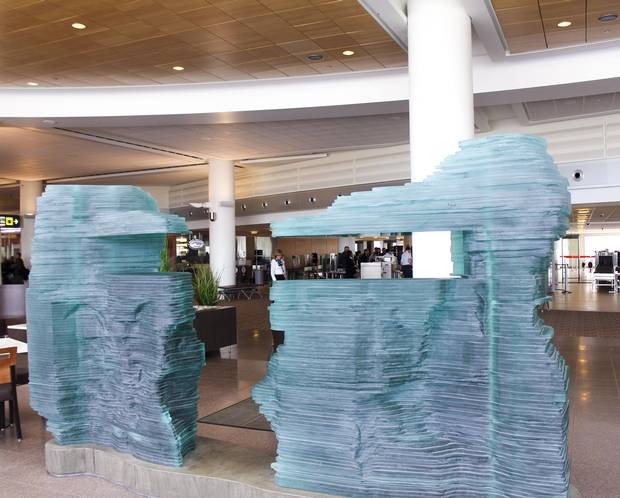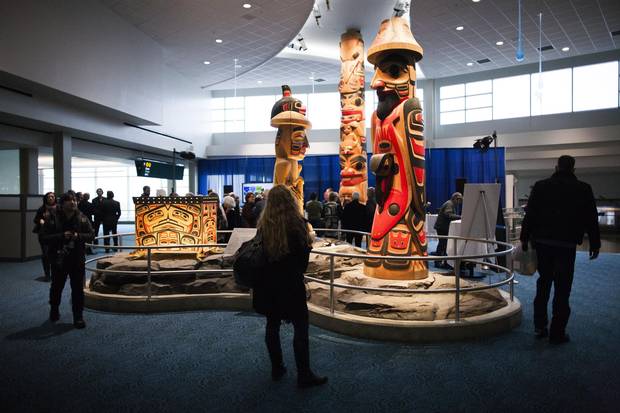On a recent stop at the Edmonton International Airport, I searched for the traveller's holy grail: a comfortable seat next to an unused power outlet. After scoping out the terminal, I saw a small corridor just off the main hallway. A row of seats banked one of the walls, with a large window pouring sunlight across the hall. At the corner, the reflection of an outlet beckoned me forward.
I took a seat, plugged my laptop in and found myself facing a wall of art.
Nearly a dozen paintings and sketches were hung on the wall opposite the chairs, with two glass cases featuring sculpture and pottery propped up below. The work spanned multiple styles and genres, but was brightly coloured and completely engaging.
I had found just one of Edmonton International Airport's art spots. This particular gallery features art from students attending Edmonton public schools. My eye was drawn to a vibrant, graphic drawing of a ladybug in flight, and above it, a series of an apple being eaten, each stage created in a different style. I spent more than 40 minutes in that gallery space, admiring the art and taking a chance to interrupt the flow of what would otherwise have been a harried and routine day. That's the goal of the mini-gallery, says Elizabeth Dwernychuk, manager of communications at the airport.
"[We consider] what the person is doing when they're seeing it or interacting with the art," Dwernychuk explained. "Are they walking? Are they rushing through security? Is this calming to them? Is it making them laugh at the gate? Do they have time to get more information or take some time to be more detailed with the art?"
Across Canada, airports are becoming much more savvy to the ways that good art and design can improve the passenger experience. Whether it's the dinosaur skeletons at Toronto's Pearson International Airport, or the large-scale sculpture Aperture in Winnipeg's Richardson International Airport, these pieces break up the routine of the traveller, promote relaxation and make the airports destinations to see in and of themselves.

Warren Carther’s Aperture is a large-scale sculpture at Winnipeg’s Richardson International Airport.
YWG
At the EIA, each permanent piece of art was chosen with the care you might find in a gallery or museum exhibition, but is unexpected at an airport. Everything Flows, Nothing Stands Still is a mosaic piece by Edmonton artist Erin Pankratz, made up of more than 4,000 glass and porcelain tiles. It represents the Edmonton landscape, with the tumbling river valley. But as a viewer gets closer, the perception changes. Dwernychuk says that's the goal for much of the artwork displayed.
"The [time] of the day, that the sun is going to shine on the art, that's going to change the appearance and create different shadows and textures," Dwernychuk said. "Looking at it from far away as opposed to when you're close to it, are there details that you see up close that maybe you wouldn't have seen from far away?"
When the EIA underwent renovations in 2012, Dwernychuk and a group of artists and architects worked together to place art throughout the new terminal, from the permanent sculptures in the lobby to smaller galleries such as the student alcove. Even the carpet was chosen deliberately – made to look like an Albertan wheat field, as seen from thousands of feet above the ground.
The new air-filtration units were turned into houses for art displays, with the pieces changing every few months; the next batch will hit the airport floor by June. Dwernychuk says it's a chance to keep things interesting for repeat travellers.
"Our rotational art program is a reflection of our community," Dwernychuk said. "When they come into our airport, they have a sense of place there."
The Edmonton International Airport is not alone in this type of thinking and planning. At Vancouver International Airport (YVR), Rita Beiks works as the in-house art curator for the airport, a position she's held since 1995.
"It's an opportunity to show artwork in places that are not typical," Beiks said. "They say 3 per cent of a population will attend a gallery, but YVR has 22 million people flying through it every year. And that's a lot of people who see art, who may never see it in the city."
For Beiks, YVR is the front door of the community, a chance to give people a taste of the art and culture that the Vancouver area offers.
"Maybe [passengers are] here on a business trip, and they're going to come here and see all this artwork … [that is] going to reference our mountains and our rivers and streams, and all the islands, and all the places they can go," Beiks said. "And they'll remember their time here. They could go to a hotel for a convention, and not remember anything except what they saw in this airport."
What passengers could see in YVR rivals any contemporary gallery in the country. The airport boasts the largest publicly displayed private collection of Northwest Coastal art. It has nearly 300 pieces, ranging from sculptures the size of a softball to towering wooden figures standing two-storeys tall.
Of the gargantuan artworks displayed across the Vancouver airport, the Musqueam Welcome Figures are the most well known. Created by local artist Susan Point in 1996, the carved red-cedar pillars are slightly more than five metres high and are inscribed with figures and symbols representing the Coast Salish people who have lived along the Fraser River for centuries.
"So many people live in Vancouver, and they'll go travelling, and when they come back and pass through that area, they'll go, 'I know I'm home,'" Beiks said. "It says home to you, and it tells you who we are and where we are."
That's the goal of art in a public space, explains Tricia Wasney, the manager of public art with the Winnipeg Arts Council. Art can make viewers think, and speak about political, environmental and social issues of the day. If it can exist in a gallery setting, an airport is no different.
"We get so used to airports as being both anonymous and generic in some ways. … You can fly into one airport and into another, and you might not know where you are after a while," Wasney lamented. "But the thing about public art and architecture is not only does it give something different to people to encounter, but it speaks to the places they're in."
Of course, there is a calming aspect to art as well. Airports can be the site of hectic and stressful events, with travellers becoming agitated and irked. But a beautiful sculpture or a thoughtful painting sets a more serene tone.
"There [are] lots of studies on how art has that effect in hospitals and other stressful spaces," Wasney said. "Art, to me, provides something to people that nothing else can. It's something that is intrinsic to our humanity, and always has been. I think that we need more than utilitarian spaces, and perfectly straight rows. … We need visual art, we need music, we need books."
Artist Pat Stewart agrees. The Nova Scotia painter has been creating watercolours for more than a decade now, and is a member of the Halifax ArtPort Gallery Co-op. Run by 10 local artists, the ArtPort is set up just inside the terminal building of the Halifax Stanfield International Airport. Each artist works a few shifts a month, creating pieces and selling art to passengers from across the world.
"The travellers often like to take back something that represents what they've seen while they're in the province," Stewart said. "There was a gentleman in today, he was looking for something on Sidney Crosby."
Stewart has sold her Maritime nature scenes to travellers heading to the United States, Europe and Africa. Her watercolours are particularly popular with passengers flying to Britain, but she says even staff at the airport are fans of the gallery.
"There's people that come in, and even people who work [at the airport], and they'll say, 'Oh, I just love to come in here and take a break,'" Stewart said.
As I walked toward my gate at the Edmonton International Airport, I was noticeably calmer. I relaxed after spending some time staring at the art, and I enjoyed my flight more. I often travel to see the sights, but the next time I'm in an airport, I'm going to take time and enjoy the view inside the terminal.
